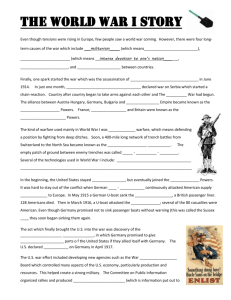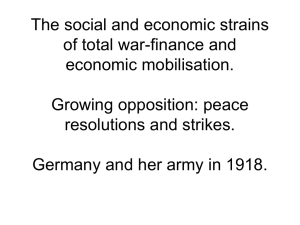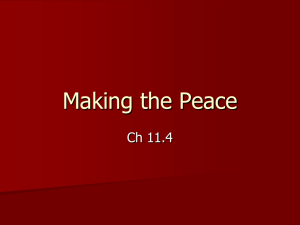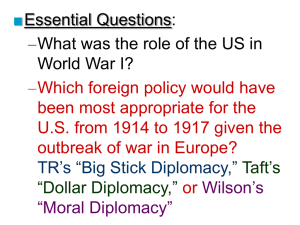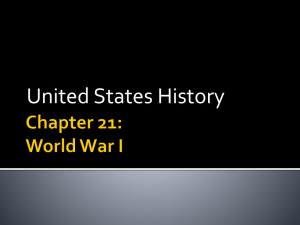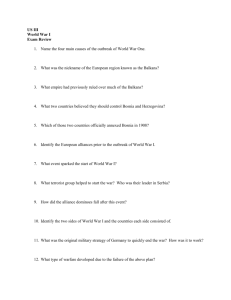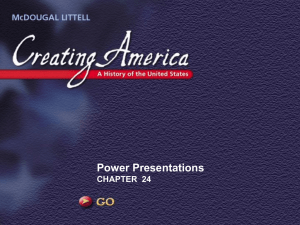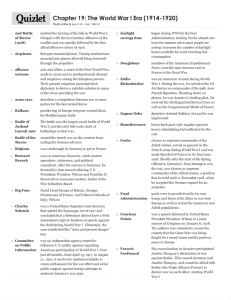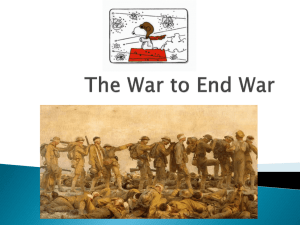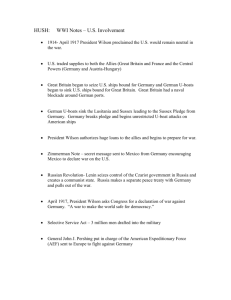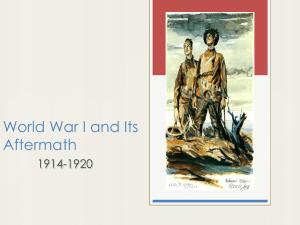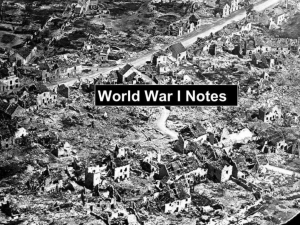The Great War - Cathedral High School
advertisement
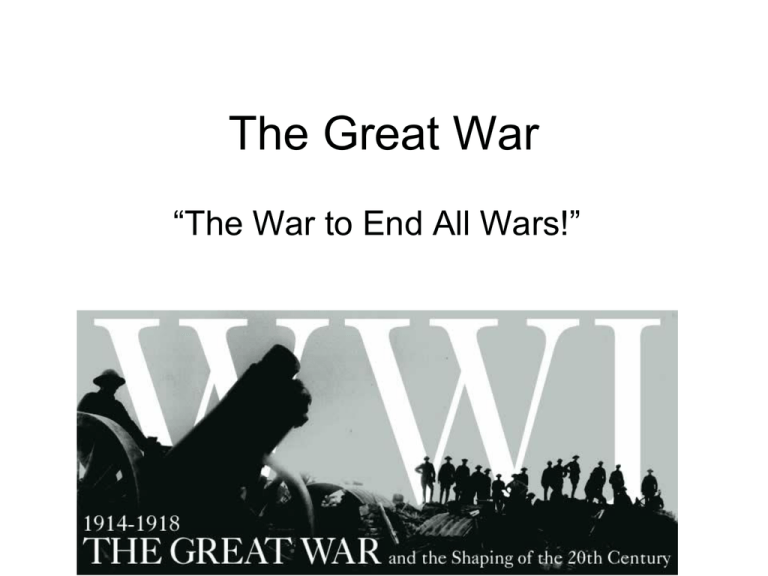
The Great War “The War to End All Wars!” The Great War Begins German Strategy: defeat France quickly, leave British forces stranded, then move on to Russia (Schlieffen Plan) Sept. 1914 - the First Battle of the Marne - Allies pushed the German lines back some 40 miles Trench Warfare By early 1915, both armies occupied hundreds of miles of trenches No-man’s-land - separated two sides, thin strip of bombed out territory Soldiers would charge through no-man’s -land toward enemy trenches as thousands were killed by machine-gun The Battle of the Somme In July 1916, Allied Powers launched an offensive near the Somme River in France British forces suffered some 60,000 casualties in a SINGLE day Battle lasted 4 months, more than 1 million dead & wounded New Weapons Machine guns fired hundreds of rounds per minute The Allies introduced tanks Most feared - poison gas Submarines/airplanes Lusitania • May 7, 1915, a U-boat torpedoed & sank the Lusitania, British passenger liner • 128 Americans were killed • “savages drunk with blood” Road to War • March 1916, the French passenger vessel Sussex was attacked injuring several Americans • Wilson threatened to cut diplomatic ties with Germany if they did not stop submarine warfare • Germany responded with the Sussex pledge - promise not to sink liners without warning or ensuring passengers’ safety Road to War • 1916 Wilson launched military “preparedness” program • National Defense Act in June 1916 - increased the number of soldiers in the regular army 90,000 175,000 • “He Kept Us Out of War” Diplomatic Relations Broken • February 1, 1917 - Germany resumed full-scale U-boat warfare • Wilson ordered the arming of U.S. merchant ships sailing into war zone • However, German torpedoed & sank 5 U.S. ships The Zimmermann Note • March 1, 1917, American newspapers published an intercepted telegram from German foreign secretary Arthur Zimmermann to a German minister in Mexico • Proposed a Mexican alliance with Germany • Angered Americans • April 2, 1917, President Wilson asked Congress for a declaration of war Preparing U.S. Military • Selective Service Act passed on May 18, 1917 - required men between the ages of 21 & 30 to register with local draft boards • Supporters of draft argued it would help build a more democratic U.S. • Massive training camps had to be built to house & train the new soldiers Over There • U.S. troops began sailing to France as part of the American Expeditionary Force (AEF) • The troops did not participate in the fighting until 1918 • Escorted by U.S. warships, merchant vessels transported troops, supplies, & volunteers (Convoy System) The War at Home Mobilizing the Nation Directing the Economy • 1st step - raise money to pay for war • Liberty Bonds during the war & Victory bonds after the end of the fighting • Government also increased taxes Conserving Resources • Food Administration - Herbert Hoover encourage agricultural production & conserve existing food supplies • “food will win the war” • Hoover guaranteed farmers high prices • Fuel Administration - Harry Garfield encouraged heatless Mondays Organizing Industry • War Industries Board (WIB) - government’s central war agency • Some business leaders were critical of Wilson’s programs • Some argued government intervention would damage U.S. system of free enterprise Mobilizing Workers • American industries became short on labor • Unionized workers across the country went on strike - higher wages & benefits • National War Labor Board (NWLB) - arbitrated disputes between workers & employers • Labor shortages strengthened unions & brought changes in the work force The End of War Revolution in Russia • March 1917 Russians demanding a change in government & an end to the war, overthrew the czar • Bolsheviks (radical Russian socialists) seized power • Vladimir Lenin, Bolshevik leader, seized power & moved quickly to remove Russia from the war Germany’s Last Try • March 21, 1918, some 1 million German soldiers launched a tremendous offensive against the Allies • “Big Bertha” • By late May Germans had pushed Allies back to Marne River • U.S. troops helped French stop the Germans at Chateau-Thierry Allied Victory • Late summer of 1918, French commander Foch ordered a major offensive along the entire western front • For 3 months the Allies pushed deep into German-held territory • By November, had reached & occupied the hills around Sedan • Battle of Argonne Forest - African American troops played a major role Allied Victory • Taking a hard hit from the Allied offensive, the Central Powers’ forces began to disintegrate • In Fall of 1918, mutinies broke out in the German army & navy • November 9 1918, Kaiser Wilhelm gave up the throne Allied Victory • November 10, 1918 German government representatives arrived at Allied Headquarters to hear the armistice terms • Allies demanded Germany evacuate & surrender military equipment • Signed armistice on November 11, 1918 - cease fire • At last, the war had ended Wilson’s 14 Points • Program for world peace • 9 of the points dealt with selfdetermination - the right of people to govern themselves • Other points focused on causes of modern war: secret diplomacy, arms race, violations of freedom of the seas, & trade barriers • Final point established the League of Nations Paris Peace Conference • Opened on January 18, 1919 • Big Four - Wilson, David Lloyd George, Georges Clemenceau, & Vittorio Orlando • The other three insisted Germany bear the financial cost of war by making huge reparations to the Allies • After 6 months of debate, the Treaty of Versailles was signed
